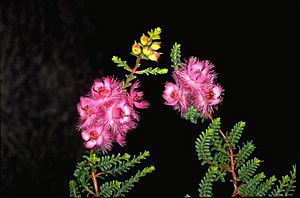Summer featherflower facts for kids
Quick facts for kids Summer featherflower |
|
|---|---|
 |
|
| Conservation status | |
| Scientific classification | |
| Genus: |
Verticordia
|
| Species: |
tumida
|
The Verticordia tumida, also known as the summer featherflower, is a beautiful flowering plant. It belongs to the myrtle family, called Myrtaceae. This plant grows only in the north-west part of Western Australia. It's an open, bushy plant with tiny leaves. It produces groups of bright pink flowers from late spring all the way into early winter.
Contents
What Does the Summer Featherflower Look Like?
The summer featherflower is an open, bushy plant. It has many branches that spread out. It usually grows to be about 80 cm (30 in) tall. Its leaves are shaped like an oval or an egg. They are very small, only about 1–3 mm (0.04–0.1 in) long and 1 mm (0.04 in) wide.
The Beautiful Flowers
The flowers of the summer featherflower have a nice smell. They grow in short, spike-like groups at the ends of the branches. Each flower sits on a small stalk about 2–3 mm (0.08–0.1 in) long. The part that holds the flower, called the floral cup, is shaped like a top. It's about 3 mm (0.1 in) long and smooth. It has thick green parts, called appendages, that are 1–2 mm (0.04–0.08 in) long.
The sepals are the leaf-like parts that protect the flower bud. They are 5–6 mm (0.20–0.24 in) long and spread out. They are a deep pink color and have 5 or 10 feathery parts. The petals, which are the colorful parts of the flower, are also deep pink. They are about 5 mm (0.2 in) long and have a fringe 2.5 mm (0.1 in) long. The style, which is part of the flower's reproductive system, is about 4 mm (0.2 in) long. It curves near the top and is a bit hairy. These lovely flowers bloom from late October to April, and sometimes even later.
How the Summer Featherflower Got Its Name
The summer featherflower, Verticordia tumida, was first officially described in 1991. A botanist named Alex George wrote its description. He studied a plant sample found near Tammin by Charles Gardner. This description was published in a science journal called Nuytsia.
The second part of its scientific name, tumida, comes from a Latin word. It means "swollen." This name refers to the swollen parts on the floral cup of the flower.
Different Types of Summer Featherflower
There are two slightly different types, or subspecies, of the summer featherflower:
- Verticordia tumida subsp. tumida has 9 or 10 feathery parts on each sepal. It also has a narrow part at the bottom of its floral cup.
- Verticordia tumida subsp. therogana has 5 to 8 feathery parts on its sepals. Its floral cup does not have a narrow part at the bottom.
Where the Summer Featherflower Lives
The tumida subspecies usually grows in sandy soil. Sometimes it can be found in soil with loam and clay. It lives in areas with heath (low-growing shrubs) and shrubland. You can mostly find it between Dowerin, Jitarning, and Koolyanobbing.
The therogana subspecies also grows in sand, often with loam. It lives in heath and shrubland areas. This type is found between Wickepin and the Peak Charles and Fitzgerald River National Parks.
Protecting the Summer Featherflower
Both types of the summer featherflower are important plants. The Western Australian Government's Department of Parks and Wildlife has looked at their numbers. They have classified both subspecies of V. tumida as "Not Threatened." This means they are not currently in danger of disappearing.
Growing Summer Featherflower in Gardens
It is easier to grow the therogana subspecies from cuttings than the tumida subspecies. It is also simpler to keep the therogana subspecies alive in a garden. However, these plants are not widely available in plant stores for people to buy.


